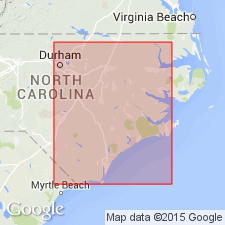
- Usage in publication:
-
- Bladen formation
- Modifications:
-
- Original reference
- Dominant lithology:
-
- Clay
- Sand
- AAPG geologic province:
-
- Atlantic Coast basin
Summary:
Pg. 93-99. Bladen formation. Sands and clays, for most part thinly laminated and often highly cross-bedded; everywhere more or less lignitic. Name used tentatively, since future investigations may prove equivalency with other formations elsewhere. A few fossil plants indicate equivalency with Tuscaloosa formation. Grades into overlying Ripley formation [Peedee] and rests unconformably on Cape Fear formation [Tuscaloosa]. Thickness 500 to 700 feet. Recognized in coastal plain of North Carolina and South Carolina. Age is Late Cretaceous.
[Named from exposures in Bladen Co., NC, especially along the Cape Fear River.]
Source: US geologic names lexicon (USGS Bull. 896, p. 209).

- Usage in publication:
-
- Bladen formation†
- Modifications:
-
- Abandoned
- AAPG geologic province:
-
- Atlantic Coast basin
Summary:
Bladen formation†. Named replaced with Black Creek formation, which has priority. [See also Sloan (1907) entry under Black Creek.]
Source: US geologic names lexicon (USGS Bull. 896, p. 209).
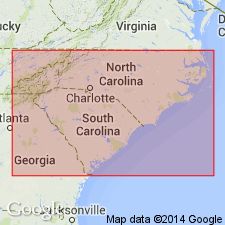
- Usage in publication:
-
- Bladen member
- Modifications:
-
- Reinstated
- AAPG geologic province:
-
- Atlantic Coast basin
Summary:
Pg. 85, chart 1. Bladen member of Black Creek formation. Stephenson's (1907) term Bladen is here reinstated as the Bladen member in the lower part of the Black Creek formation. [Age is Late Cretaceous.]
[Justification for reinstatement is in Heron's unpublished Ph.D dissertation "The stratigraphy of the outcropping basal Cretaceous formations between the Neuse River, North Carolina, and the Lynches River, South Carolina", University of North Carolina, Chapel Hill, NC.]
Source: US geologic names lexicon (USGS Bull. 1200, p. 378); GNU records (USGS DDS-6; Reston GNULEX).

- Usage in publication:
-
- Bladen member
- Modifications:
-
- Areal extent
- AAPG geologic province:
-
- Atlantic Coast basin
Summary:
Pg. 5-6, 19. [Bladen member of Black Creek formation.] Consists of alternating thin beds of clay and sand, masses of relatively pure loose sand, lignitized wood, and marcasite in basal portion followed by medium to coarse sand and clayey sand; more than 60 percent of member is sand. Thickness about 16 feet. Outcrop relations of Cape Fear, Middendorf, and Bladen units are open to several interpretations; view that Middendorf represents an updip part of the Bladen seems preferable. Bladen rests on the Cape Fear in downdip exposures, and Middendorf rests on the Cape Fear in updip exposures in Fort Bragg, [North Carolina].
Source: US geologic names lexicon (USGS Bull. 1200, p. 378).
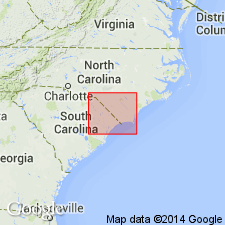
- Usage in publication:
-
- Bladen Formation*
- Modifications:
-
- Revised
- AAPG geologic province:
-
- Atlantic Coast basin
Summary:
The name Bladen, which had been used as the lower member of the Black Creek Formation by Heron (1958), is here revised as a formation in the Black Creek Group. [See Sohl and Owens (1991) for revision.]
Source: GNU records (USGS DDS-6; Reston GNULEX).
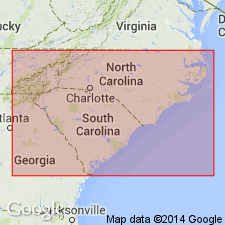
- Usage in publication:
-
- Bladen Formation*
- Modifications:
-
- Revised
- AAPG geologic province:
-
- Atlantic Coast basin
Summary:
The Bladen Member of the Black Creek Formation of Heron (1958) is here revised as Bladen Formation, the middle unit of the Black Creek Group (revised) in the Pee Dee River valley, SC and the Cape Fear Valley, NC. It corresponds to the upper more marine part of Heron's Bladen Member. The lower part of Heron's Bladen is here named the Tar Heel Formation. It consists of black clay and light-colored, micaceous, glauconitic, fossiliferous sand deposited in a shallow shelf environment. Overlies the Tar Heel and underlies the Donoho Creek Formations, (new names) of the Black Creek. Thickness is up to 180 ft. Age is late Campanian, based on palynomorphs and mollusks.
Source: GNU records (USGS DDS-6; Reston GNULEX).
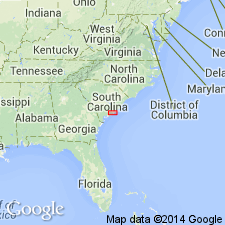
- Usage in publication:
-
- Bladen Formation*
- Modifications:
-
- Principal reference
- Revised
- Age modified
- Biostratigraphic dating
- AAPG geologic province:
-
- Atlantic Coast basin
Summary:
Pg. 11 (fig. 8), 25-26, 31 (fig. 22), 35. Bladen Formation of Black Creek Group. Sediments previously included in the Peedee Formation by Hazel and others (1977) and Gohn and others (1977). Consists mostly of gray, calcareous, clayey silts and silty clays. Thickness 142 feet at principal reference section. Overlies Coachman Formation (new) and underlies Donoho Creek Formation; both of Black Creek Group. Fossils (forams, nannofossils, ostracods, mollusks). Age is Late Cretaceous (latest Campanian; latest Tayloran Provincial Age; GLOBOTRUNCANITA CALCARATA planktic foram zone, QUADRUM TRIFIDUM (NC20) calcareous nannofossil zone, LIMBURGINA VERRICULA ostracode zone).
Principal reference section (subsurface): depth-interval 1,072 to 1,214 ft, Clubhouse Crossroads No. 1 drill core, near Clubhouse Crossroads, Dorchester Co., southeastern SC.
Source: Publication.
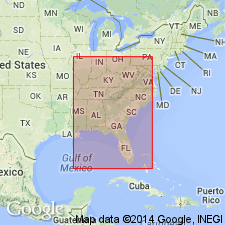
- Usage in publication:
-
- Bladen Formation*
- Modifications:
-
- Biostratigraphic dating
- AAPG geologic province:
-
- Atlantic Coast basin
Summary:
Bladen Formation shown as Late Cretaceous (late Campanian) on fig. 1. Late Campanian age based on CRASSATELLA HODGEI collected from Marion Co., northeastern SC, and Sampson, Lenoir, and Bladen Cos., eastern NC.
Source: GNU records (USGS DDS-6; Reston GNULEX).
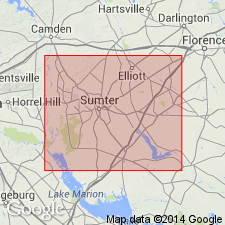
- Usage in publication:
-
- Bladen Formation*
- Modifications:
-
- Areal extent
- Age modified
- AAPG geologic province:
-
- Atlantic Coast basin
Summary:
Black Creek Group strata in corehole in Sumter Co., central SC, are similar to subdivisions of Black Creek strata described by Sohl and Owens (1991) for NC and eastern SC. In the study area, the subdivisions of Black Creek Group are queried as Tar Heel(?) Formation, Bladen(?) Formation, and Donoho Creek(?) Formation [until more detailed information is known]. Figure 4 shows correlation with Cusseta Sand Member of Ripley Formation in AL and assignment to Tayloran provincial stage.
Source: GNU records (USGS DDS-6; Reston GNULEX).
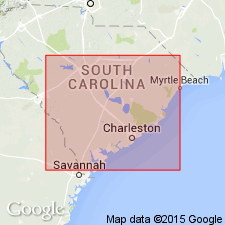
- Usage in publication:
-
- Bladen Formation*
- Modifications:
-
- Age modified
- Biostratigraphic dating
- AAPG geologic province:
-
- Atlantic Coast basin
Summary:
Bladen Formation. Age is Late Cretaceous (middle Campanian). Fossils indicate the Bladen occurs within: (1) COMPLEXIOPOLLIS ABDITUS palynological zone, proposed herein; (2) CC21 calcareous nannofossil zone of Sissingh (1977, 1978); (3) EXOGYRA PONDEROSA Coastal Plain mollusk zone of Stephenson (1923); and (4) BOSTRYCHOCERAS POLYPLOCUM European Tethyan ammonoid zone of Gradstein and others (1995, 2004).
Source: Publication.
For more information, please contact Nancy Stamm, Geologic Names Committee Secretary.
Asterisk (*) indicates published by U.S. Geological Survey authors.
"No current usage" (†) implies that a name has been abandoned or has fallen into disuse. Former usage and, if known, replacement name given in parentheses ( ).
Slash (/) indicates name conflicts with nomenclatural guidelines (CSN, 1933; ACSN, 1961, 1970; NACSN, 1983, 2005, 2021). May be explained within brackets ([ ]).

